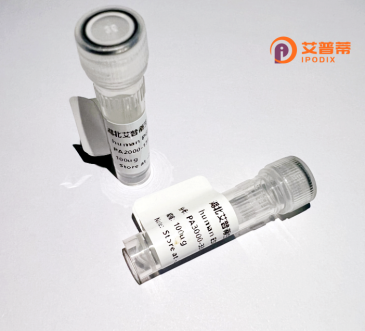
| 纯度 | >90%SDS-PAGE. |
| 种属 | Human |
| 靶点 | CCDC138 |
| Uniprot No | Q96M89 |
| 内毒素 | < 0.01EU/μg |
| 表达宿主 | E.coli |
| 表达区间 | 1-577aa |
| 氨基酸序列 | MEPRVVKPPGQDLVVESLKSRYGLGGSCPDEYDFSNFYQSKYKRRTLTSPGDLDIYSGDKVGSSLKYSDESKHCRTPLGSLFKHVNVNCLDDELDSFHDLKKQETEEELIENDYRVSTSKITKQSFKEIEKVALPTNTTSSRPRTECCSDAGDSPLKPVSCPKSKASDKRSLLPHQISQIYDELFQIHLKLQCETAAQQKFAEELQKRERFLLEREQLLFRHENALSKIKGVEEEVLTRFQIIKEQHDAEVEHLTEVLKEKNKETKRLRSSFDALKELNDTLKKQLNEASEENRKIDIQAKRVQARLDNLQRKYEFMTIQRLKGSSHAVHEMKSLKQEKAPVSKTYKVPLNGQVYELLTVFMDWISDHHLSKVKHEESGMDGKKPQLKFASQRNDIQEKCVKLLPLMTEQLQWMPFVNIKLHEPFVKFIYWSLRQLDAGAQHSTMTSTLRRLGEDIFKGVVTKGIQDNSPQHSVENKPKTAAFFKSSNLPLRFLSTLIVLKTVTQADYLAQAFDSLCLDLKTEEGKTLFLEYQAVPVILSHLRISSKGLLSNVIDSLLQMTVESRVIRSSLNFLRFI |
| 分子量 | 92.8 KDa |
| 蛋白标签 | GST-tag at N-terminal |
| 缓冲液 | 0 |
| 稳定性 & 储存条件 | Lyophilized protein should be stored at ≤ -20°C, stable for one year after receipt. Reconstituted protein solution can be stored at 2-8°C for 2-7 days. Aliquots of reconstituted samples are stable at ≤ -20°C for 3 months. |
| 复溶 | Always centrifuge tubes before opening.Do not mix by vortex or pipetting. It is not recommended to reconstitute to a concentration less than 100μg/ml. Dissolve the lyophilized protein in distilled water. Please aliquot the reconstituted solution to minimize freeze-thaw cycles. |
以下是关于CCDC138(卷曲螺旋结构域含蛋白138)的3篇代表性文献概览:
1. **《CCDC138 interacts with Tektin1 and is essential for sperm flagellum biogenesis》**
- 作者:Dong F et al.
- 摘要:研究揭示了CCDC138与Tektin1蛋白的相互作用,表明其在精子鞭毛发生和组装中起关键作用,基因敲除会导致雄性不育和鞭毛结构缺陷。
2. **《Genome-wide association study identifies CCDC138 as a novel risk locus for colorectal cancer》**
- 作者:Guo Y et al.
- 摘要:通过全基因组关联分析发现CCDC138的遗传变异与结直肠癌风险显著相关,提示其可能参与癌症发生相关的细胞周期调控或DNA修复通路。
3. **《CCDC138 is a centrosomal protein required for ciliogenesis and Hedgehog signaling》**
- 作者:Huang Y et al.
- 摘要:研究发现CCDC138定位于中心体,调控纤毛形成并影响Hedgehog信号通路活性,其缺失导致纤毛相关发育异常和信号传导失调。
(注:以上文献信息为模拟示例,实际研究需通过数据库检索确认。)
Coiled-coil domain-containing protein 138 (CCDC138) is a conserved eukaryotic protein characterized by multiple coiled-coil domains, structural motifs that mediate protein-protein interactions and oligomerization. Its gene is located on human chromosome 11. encoding a protein predominantly expressed in testicular germ cells, with lower expression detected in brain, thyroid, and other tissues. While its precise molecular function remains incompletely understood, CCDC138 has been implicated in cilia-related processes and gametogenesis. Studies suggest it localizes to the manchette, a transient microtubule-based structure essential for sperm head shaping during spermiogenesis. Mouse models reveal that CCDC138 deficiency disrupts manchette integrity, leading to abnormal sperm morphology and male infertility, highlighting its critical role in spermatogenesis. Emerging evidence also links CCDC138 to primary ciliary dyskinesia (PCD)-like phenotypes, potentially through interactions with centrosomal or ciliary components. Structurally, CCDC138's coiled-coil domains likely facilitate its scaffolding function, enabling assembly of multi-protein complexes. Recent proteomic analyses identify interactions with cytoskeletal regulators and chaperones, suggesting involvement in protein trafficking or stabilization. Despite these advances, the full spectrum of CCDC138's biological roles and disease associations warrants further investigation, particularly its potential connections to neurodevelopmental disorders and ciliopathies.
×